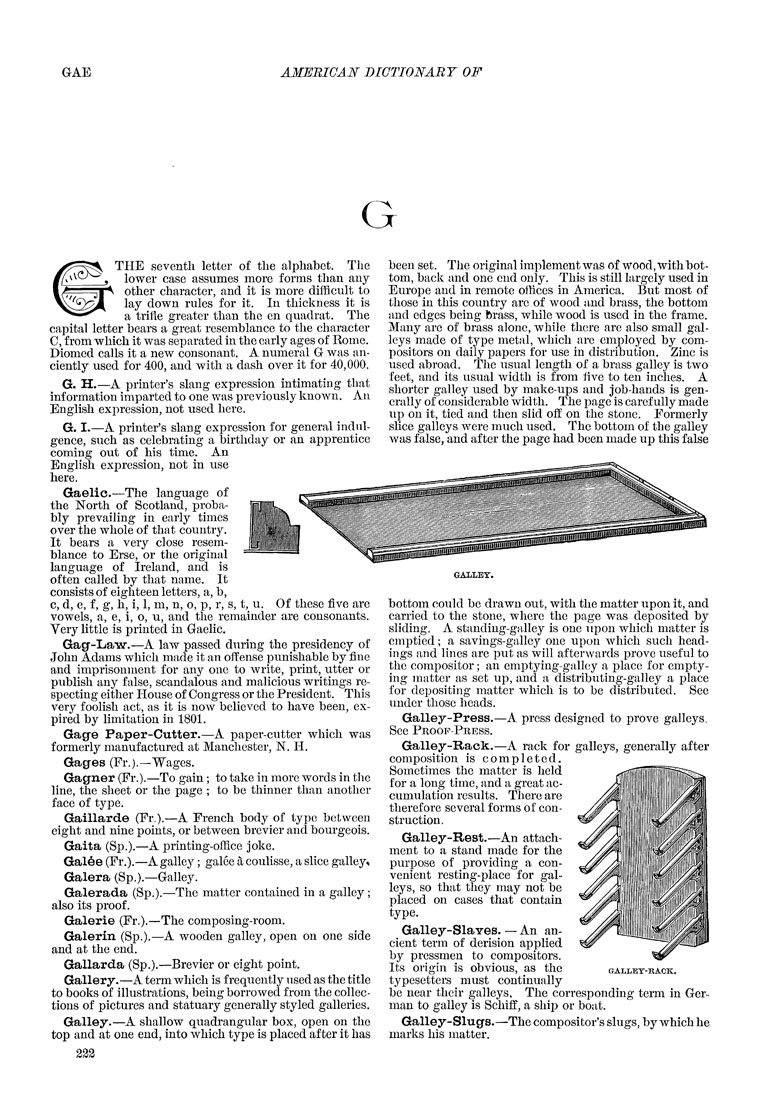GAE
AMERICAN DICTIONARY OF
G
, s, t, u. Of these five are
THE seventh letter of the alphabet. The
lower case assumes more forms than any
^ other character, and it is more difficult to
lay down rules for it. In thickness it is
a trifle greater than the en quadrat. The
capital letter bears a great resemblance to the character
C, from which it was separated in the early ages of Rome.
Diomed calls it a new consonant. A numeral G was an¬
ciently used for 400, and with a dash over it for 40,000.
G. H.—A printer's slang expression intimating that
information imparted to one was previously known. An
English expression, not used here.
G. I.—A printer's slang expression for general indul¬
gence, such as celebrating a birthday or an apprentice
coming out of his time. An
English expression, not in use
here.
Gaelic.—The language of
the North of Scotland, proba¬
bly prevailing in early times
over the whole of that country.
It bears a very close resem¬
blance to Erse, or the original
language of Ireland, and is
often called by that name. It
consists of eighteen letters, a, b,
c, d, e, f, g, h, i, 1, m, n, o, p, r,
vowels, a, e, i, o, u, and the remainder are consonants,
Very little is printed in Gaelic.
Gag-La-w.—A law passed during the presidency of
John Adams which made it an offense punishable by fine
and imprisonment for any one to write, print, utter or
publish any false, scandalous and malicious writings re¬
specting either House of Congress or the President, This
very foolish act, as it is now believed to have been, ex¬
pired by limitation in 1801,
Gage Paper-Cutter.—A paper-cutter which was
formerly manufactured at Manchester, N, H.
Gages (Fr.).—Wages.
Gagner (Fr.).—To gain; to take in more words in the
line, the sheet or the page ; to be thinner than another
face of type.
Gaillarde (Fr.).—A French body of type between
eight and nine points, or between brevier and bourgeois.
Gaita (Sp.).—A printing-office joke.
Gal6e (Fr.).—A galley; galee ^ coulisse, a slice galley«
Galera (Sp.).—Galley.
Galerada (Sp.).—The matter contained in a galley;
also its proof.
Galerie (Fr.).—The composing-room.
Galerin (Sp.).—A wooden galley, open on one side
and at the end.
Gallarda (Sp.).—Brevier or eight point.
Gallery.—A term which is frequently used as the title
to books of illustrations, being borrowed from the collec¬
tions of pictures and statuary generally styled galleries.
Galley.—A shallow quadrangular box, open on the
top and at one end, into which type is placed after it has
222
been set. The original implement was of wood, with bot¬
tom, back and one end only. This is still largely used in
Europe and in remote offices in America. But most of
those in this country are of wood and brass, the bottom
and edges being brass, while wood is used in the frame.
Many are of brass alone, while there are also small gal¬
leys made of type metal, which are employed by com¬
positors on daily papers for use in distribution. Zinc is
used abroad. The usual length of a brass galley is two
feet, and its usual width is from five to ten inches. A
shorter galley used by make-ups and job-hands is gen¬
erally of considerable width. The page is carefully made
up on it, tied and then slid off on the stone. Formerly
slice galleys were much used. The bottom of the galley
was false, and after the page had been made up this false
bottom could be drawn out, with the matter upon it, and
carried to the stone, where the page was deposited by
sliding. A standing-galley is one upon which matter is
emjDtied; a savings-galley one upon which such head¬
ings and lines are put as will afterwards prove useful to
the compositor; an emptying-galley a place for empty¬
ing matter as set up, and a distributing-galley a place
for depositing matter which is to be distributed. See
under those heads.
Galley-Press.—A press designed to prove galleys.
See Proof-Press.
Galley-Rack.—A rack for galleys, generally after
composition is completed.
Sometimes the matter is held
for a long time, and a great ac¬
cumulation results. There are
therefore several forms of con¬
struction.
Galley-Rest.—An attach¬
ment to a stand made for the
purpose of providing a con¬
venient resting-place for gal¬
leys, so that they may not be
placed on cases that contain
type.
Galley-Slaves. — An an¬
cient term of derision applied
by pressmen to compositors.
Its origin is obvious, as the
typesetters must continually
be near their galleys. The corresponding term in Ger¬
man to galley is Schiff, a ship or boat.
Galley-Slugs.—The compositor's slugs, by which he
marks his matter.
GALLEY-RACK.
|








